Hotel Project Moves Ahead, Condos Delayed
Ann Arbor planning commission meeting (May 20, 2014): Development of a new extended-stay hotel on West Huron and North Ashley received a unanimous recommendation of approval from planning commissioners, following a lengthy discussion and concerns voiced by some residents and business owners at the adjacent One North Main building.
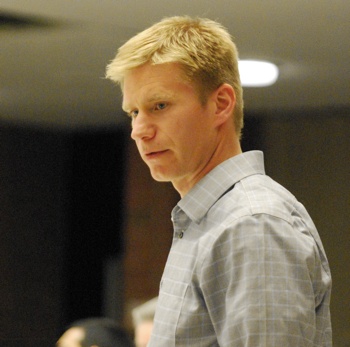
Mike Martin of First Martin Corp. answered questions from planning commissioners at their May 20, 2014 meeting. (Photos by the writer.)
Issues included blocked views, noise from rooftop mechanicals, and problems with egress from One North Main’s underground parking. But even people who raised these concerns applauded the project, saying a hotel there would help bring vitality to that part of town. The site on the northeast corner, owned by First Martin Corp., now includes a building that houses the Ann Arbor Convention & Visitors Bureau and the bus depot for Greyhound, which will be relocating next month to the city’s Fourth & William parking structure.
First Martin’s proposal includes a six-floor, 88,570-square-foot building with a ground-floor restaurant or retail space facing Huron and an extended-stay hotel on the upper five levels, with an entrance off of Ashley. The hotel will be operated by Marriott. The bus depot facade – including an iconic art moderne sign – will remain in place.
The project will be forwarded to the city council for consideration.
Also heading to the council with a recommendation of approval is an expansion of the Bank of Ann Arbor’s downtown building at the northeast corner South Fifth and East Washington. The plan involves reorienting the main entrance – moving it from the center of the bank’s South Fifth Avenue side to the corner of Fifth and Washington. A 9,179-square-foot third-floor addition would be constructed over the rear of the building’s east side.
The bank has an existing drive-thru teller window on its north side, which will not be altered. The site’s D1 zoning requires a special exception use for drive-thrus, which the planning commission granted in a separate vote. Because the project is going through a site plan approval process, the requirement for a special exception use was triggered. Special exception uses do not require additional city council approval.
Commissioners amended the special exception use to limit the drive-thru to a financial institution, so that it can’t be used in the future for other businesses – like a pharmacy or fast food restaurant. That amendment, put forward by Sabra Briere, was approved on a 6-2 vote, over dissent from Wendy Woods and Eleanore Adenekan. Briere also proposed an amendment that would restrict the hours that the drive-thru could be open. The concern was that vehicles pulling out from the drive-thru onto Fifth Avenue could cause a threat to pedestrians and bicyclists in the evening. But after discussion – including some comments from Hans Maier, a senior executive for the bank – Briere withdrew that amendment.
Two other special exception use requests were granted during the May 20 meeting – from companies selling seasonal Class C fireworks for the July 4 holiday. Phantom Fireworks will be putting up a tent in the parking lot of the Maple Village Shopping Center, across from Veterans Memorial Park. In previous years the business operated in the parking lot of Colonial Lanes on South Industrial. Patriot Fireworks will be selling fireworks in the parking lot of the Twin Valley shopping center at 2750 Jackson Ave., west of the I-94 overpass. Both special exception uses were amended to limit the sales to fireworks only – not other seasonal items – and to put specific limits on the days of operation.
One item was postponed by commissioners on May 20 – a site plan for Mark Condominiums on West Liberty, brought forward by developer Alex de Parry. The postponement was based on a recommendation from the planning staff, to allow time for a public water system issue to be addressed. City staff determined that the six-inch water main along Liberty needs to be replaced with a 12-inch main. De Parry told commissioners that the development team had just recently been informed about this issue, and they are now analyzing the budget impact and alternatives they might pursue.
Downtown Hotel
The site plan and development agreement for a new downtown hotel at the northeast corner of North Ashley and West Huron were on the May 20 agenda.

Rendering of proposed hotel at the northeast corner of West Huron and Ashley. The One North Main building is visible to the east.
The proposal brought forward by First Martin Corp. calls for a six-floor, 88,570-square-foot building with a ground-floor restaurant or retail space and an extended-stay hotel on the upper five levels. The hotel will be operated by Marriott.
The current site at 116-120 W. Huron includes a Greyhound bus depot and a one-story building that houses the Ann Arbor Convention & Visitors Bureau. Both of those buildings will be demolished. The bus depot facade will remain in place as part of the new building’s design. [.pdf of staff report]
The main hotel entrance is proposed for the building’s west side, facing North Ashley, while the main entrance for the restaurant or retail space is proposed to face West Huron, on the building’s south side. The site is zoned D1, which allows for the highest density development in the downtown. According to the staff memo, five off-street parking spaces are required. First Martin has secured a letter of commitment from Zipcar, a car-sharing service, for two vehicles. Parking spaces for those cars are proposed at the northeast corner of the site. For purposes of the city’s parking requirement, the two Zipcars would count as eight off-street parking spaces, and would satisfy the requirement.
The two existing curbcuts – on North Ashley and West Huron – will be closed, and access to the two parking spaces, loading dock and trash/recycling would be from the mid-block alley to the north. The alley is currently one-way, and will be converted to a two-way alley and repaved.
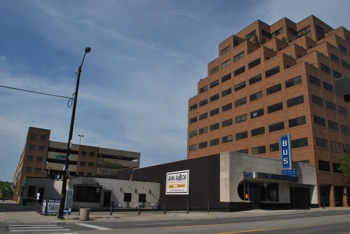
The current site at 116-120 W. Huron, looking north. One North Main is the building on the right. The city’s Ann Ashley parking structure is visible in the background.
Streetscape changes will include curb bump-outs on North Ashley, on the north and south ends of the site for passenger drop-off.
Nine bicycle parking spaces are required for the project, and would include two bike hoops in the North Ashley right-of-way and two in the West Huron right-of-way, for a total of eight bike spaces. Three more hoops are proposed for the Ann Ashley parking structure, with First Martin paying for labor and materials. The city of Ann Arbor and Downtown Development Authority would assume responsibility for maintenance of those hoops. The installation of hoops in the city’s right-of-way will require city council approval. The planning commission was asked to make a recommendation on that as well.
Construction is estimated to cost $13 million.
In giving the staff report, city planner Alexis DiLeo noted that the Greyhound bus depot has been at that location since 1940, and the site has been a transportation hub since 1898.
Downtown Hotel: Public Hearing
Four people spoke during the public hearing about this project. Changmin Fan told commissioners that Ann Arbor is expanding, and he was impressed by the proposed hotel. But there are also challenges. The city needs to consider how to maintain a dynamic downtown, he said.
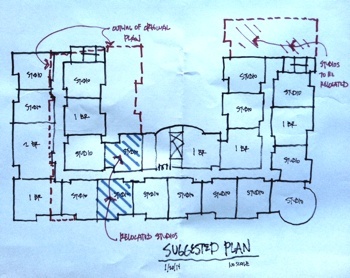
This hand-drawn alternative site plan proposed by Todd Sachse representing One North Main was passed out at the May 20 planning commission meeting.
Todd Sachse represented One North Main, the office and residential building east of the hotel site, on the northwest corner of Main and Huron. They were happy to see a development on that site and the hotel will be a great contribution to downtown, he said. However, the current design will block about half of the windows on the west side for the commercial condominiums. So he proposed an alternative plan that would shift the building about 12-15 feet to the west, and extend the building to the north. To do this, it would require cooperation from the city and from First Martin. The alternative plan would result in the same amount of square footage and rooms, Sachse said. He thought that if the city cooperated quickly, it could be accomplished in a way that would be a win-win-win for the new development, the city, and One North Main.
Stephen Ranzini introduced himself as a resident of One North Main and president of University Bank. He thanked First Martin for proposing a hotel on this site, saying it’s an excellent building. He cautioned against doing anything that would damage the value of the adjacent property, however.
In addition to the issues Sachse had mentioned, Ranzini warned against noise generated by mechanical systems on top of the hotel. There needs to be baffling of air-conditioning systems and elevators, he said. Residents on the upper floors of One North Main, on the west side, enjoy the amenity of their outdoor balconies, he noted. If the noise from the hotel is loud, that would be damaging. Ranzini criticized the city for ignoring noise coming from the top of the nearby KeyBank building. “This is a good example of bad planning leading to persistent bad results, right?”
Another issue is the exit from the underground parking at One North Main, Ranzini said. It’s very valuable to have parking underneath your downtown building, he noted – each resident has two spaces. But people illegally block egress, he said, and there’s concern that the hotel will exacerbate that situation. It’s important to preserve the value of existing investments, he said, while new investments come in. He also complained about the signs on the Ann Ashley public parking structure, saying that they’re inadequate to indicate entry and egress.
Richard Broder spoke on behalf of the One North Main condominium association, which includes both residential and commercial condos. He thought the hotel proposal was right for the community, but he shared concerns of previous speakers. He hoped planning commissioners would consider issues related to the back alley and the separation of the buildings.
Downtown Hotel: Commission Discussion
Sabra Briere asked First Martin Corp. representatives – Mike Martin and Darren McKinnon – to answer some questions about the concerns raised during public commentary by residents of One North Main. What’s been done in the design phase to address those concerns?
Martin replied that the design team has met with representatives of both the residential and commercial condo associations. Prior to submitting the hotel proposal, Martin said they worked with the city to make two-way access and egress off of the Ann Street alley. Having more ways to get into and out of that area is important, he said. One problem in the past has been dumpsters, he noted. They’ve worked with city staff and the Ann Arbor Downtown Development to potentially designate some parking spaces for delivery vehicles. Martin said they share concerns about having a functional alley, so they’re working to improve the circulation and plan to enforce “good parking behavior.”
Briere was also interested in the issue of noise from rooftop mechanicals. What has the hotel design done to baffle sound?
McKinnon replied, saying they’d talked to Ranzini about this issue. They brought an acoustic consultant on board as part of the design team, and there will be screening on the roof for both visuals and sound, he said. They’re making every effort to limit the impact, he said. Martin added that each hotel room has VTAC (vertical terminal air conditioning) units. Because there’s not a central system, the amount of equipment on the roof will be greatly reduced, he said.
Briere asked the staff if the city has looked into dedicating two of the metered spaces in the city-owned Ann Ashley parking lot for delivery. Not yet, Alexis DiLeo replied, but that’s something that could be explored. Responding to another query from Briere, DiLeo indicated that other issues related to the midblock alleys, including better directional signs from the parking area, could be discussed. Martin noted that First Martin has contributed to the cost of installing a security camera so that Republic Parking, which manages the city’s parking system on behalf of the DDA, can monitor the area.
These issues are moving in a positive direction, Briere said. Her biggest concern is that as new buildings are added, there are all these other “moving pieces” that need to be considered. She referred to additional issues raised in an email from Kathy and Angelos Constantinides, who are One North Main residents. [.pdf of Constantinides email]
Kirk Westphal asked staff to describe what’s allowed, in terms of noise and air rights. He also asked for an explanation about the building separation issue, noting that sometimes people wonder why some projects have a blank wall with no windows – it’s because another building could be constructed right next to it, he said.
Regarding building separation, DiLeo explained that the One North Main project was a planned unit development (PUD). When it was built, it received a variance from the city’s building board of appeals to have windows on its west facade at the property line. Normally, windows are either prohibited or the size is greatly reduced because of issues like fire penetration and the fact that an adjacent building could also be built up to the property line. DiLeo was under the impression that the variance indicated the windows would need to be closed if another building was constructed adjacent to it. “So they enjoyed 30 or 40 years of windows,” she said.
Regarding noise, the city code is a bit antiquated in terms of noise decibel level, DiLeo said. It worked well when there were no residents downtown, but now it doesn’t seem to adequately address noise for residents. The staff has worked with the developer to voluntarily include noise buffers and other design aspects that minimize noise, she said.
Diane Giannola asked where the mechanicals would be located, in relation to One North Main residents. McKinnon replied that air-conditioning compressors are notoriously the loudest mechanical systems. “There’s none of that on the roof whatsoever,” he said. Most of the rooftop equipment will be for ventilation of the hotel’s public corridors.
Martin added that there are two floors of vertical separation between the hotel rooftop and the residential floors of One North Main. The hotel is six stories, and residential units of One North Main begin on the eighth floor. From the audience, Ranzini said: “The noise goes up.” That’s a valid point, Martin replied, but it’s a couple of floors down and also offset from the property line. Martin hoped that the design and less noisy new equipment “would win the day” in terms of reducing noise.
Giannola asked if the window units would make noise. McKinnon replied that when the units are on, it makes about as much noise as the compressor of a home air-conditioning unit. They don’t run all at once, he noted.
Ken Clein pointed to a relevant section in the development agreement, which states: “(P-11) To design, construct, repair and maintain this development in accordance with the provisions of Chapter 119 (Noise Control) to ensure that any noise emanating from said development will not impact nearby residents or businesses. In addition, PROPRIETOR shall review existing noise sources surrounding said development and incorporate necessary design and construction techniques to ensure that future tenants will not be exposed to noise sources in violation of Chapter 119.”
Westphal asked staff to explain who residents can contact if construction noise becomes a problem. DiLeo said she can give contact info to the One North Main condo associations. Typically, the responsibility for enforcing issues related to construction fall to the city’s building department or the police department’s community standards unit.
Clein asked about the at-grade pedestrian passageway between One North Main and the hotel site, leading back to the parking area. He knew it wasn’t First Martin’s responsibility, but wondered if they planned to enhance it in any way. Martin replied that there will be some lighting and landscaping, to give it a “softer edge.” He also thought that having more people in that area would help that entire corridor.
Responding to another query from Clein, Martin said they don’t yet have a tenant identified for the retail/restaurant space.
Wendy Woods asked about the car-sharing service. Martin explained that the Zipcars would be available to anyone who had a membership with that company – it wasn’t just limited to hotel guests. The hope would be that someone could take the Ann Arbor Area Transportation Authority’s AirRide from the Detroit Metro airport to Ann Arbor, then use Zipcar to get around town.
Westphal asked how comfortable Martin was that the space fronting Huron would be leased to a retailer or restaurant. He was very confident, Martin replied. They’ve had some conversations with local restauranteurs, and have signed up with a commercial brokerage to show it. Early indications are very positive, he said, but they haven’t signed anyone up yet. Martin said he expected they’d end up with a restaurant there that would complement the hotel.
Westphal asked if that’s something that First Martin would be willing to include in the development agreement – a commitment to restaurant or retail uses? Martin indicated they’d be willing to talk about that. The ground floor of the hotel will be an extremely active use, he noted. However, he’d like to have as much flexibility as possible in the development agreement. Twenty years ago, no one would have said that a brokerage firm would be an active retail use, he noted, but now it is.
Westphal clarified that he didn’t want to see office or any kind of financial use there, which elicited a laugh from other commissioners. [Westphal has been vocal about how banks and other financial institutions with storefronts create dead space along a street.]
Jeremy Peters asked whether the hotel would have valet service, to help some of the issues related to drop-offs, traffic and parking. Martin replied that they’d talked with Art Low of Republic Parking, with the intent of working out an agreement for valet service to use some of the nearby public parking spaces.
Briere noted that the draft development agreement mentions footing drain disconnects. She was under the impression that First Martin was working on an alternative to footing drain disconnects. McKinnon said he’s met with city staff on this issue, and is planning to take some ideas to the citizens advisory committee for the sanitary sewer wet weather evaluation study. He hopes to participate as the committee develops recommendations for city council.
Martin added that they’re certainly willing to mitigate, but they’d like to have language in the development agreement that would provide for some flexibility, if the footing drain disconnect program changes.
There was some back-and-forth between Briere, Martin and McKinnon about the two different types of city programs – a residential footing drain disconnection program, and a developer offset mitigation program. McKinnon noted that the two programs are different, but related.
Woods referenced the hand-drawn alternative design that Todd Sachse had distributed during his public commentary. She urged Sachse to discuss it with the First Martin team. Kirk Westphal asked Martin about that alternative design in relation to the city’s mandated citizen participation meeting.
Martin replied that the One North Main representatives were having “off-line” conversations with First Martin about this alternative design. “We evaluated it,” he said. “We came up with a number of reasons why it did not work for us in our development.” The primary reason is that the alternative design would require getting easements from the city, he added. It’s uncertain that the city would grant the easements, and unclear how long the process might take.
One other problem is that if the hotel is taller than six floors, it would require compliance with the city’s high-rise code and also affect First Martin’s agreement with Marriott. “We’ve been on record with [Sachse] telling them it’s just not something we can do,” Martin said.
Briere asked for clarification about where hotel patrons will be dropped off. Martin replied that the drop-off, loading and unloading will be along North Ashley. There might be some sort of outdoor cafe space in front of the hotel, and a couple of on-street parking spaces. He confirmed for Briere that the hotel will include front-desk concierge service to contact taxis for customers.
Clein noted that the commission’s packet on this project includes comments from the city’s design review board. He wondered which suggestions were incorporated into the hotel design. Martin indicated that there hadn’t been unanimity of opinion among design review board members. The main takeaway was that the style of the bus depot was art moderne, not art deco, he said, “so our wrists were slapped.” He also said that board members suggested the design should be simplified a bit.
Martin noted that the site is located on the first block created within the city of Ann Arbor, so they’ve encountered a lot of “fun” issues dealing with easements and title searches for the back alley area, he said. Related to the site’s historic nature, the design review board thought it would be good for the Huron Street facade to tie into the cadence of an original city block, which was 66-feet wide. The board also wanted to carry the horizontal element of the art moderne style from Huron Street and wrap it around to the Ashley side too. It was difficult to balance all the comments, Martin said.
Clein thought the revised design was an improvement. He noted that it wasn’t the planning commission’s purview, but he thought the light-colored materials proposed for the top of the building felt a little heavy. He suggested having the brick continue up to the cornice, which he thought would make the cornice stand out more.
Regarding the bus depot facade, Clein noted that some preservationists would want to save more of the building behind it, “but in reality, there’s not a lot of integrity behind the facade.” He thought First Martin’s approach of protecting it in place during construction is preferable to dismantling it then reinstalling the facade later. He clarified with staff that this preservation qualifies the project to get premiums (a 50% floor area “bonus” of an additional 4,352 square feet) for historic preservation. “Where do we draw the line to say that allows you to qualify for premiums?” Clein asked.
DiLeo replied that premiums are awarded for historic preservation when a project preserves something that’s eligible to be on the National Register of Historic Places. The bus depot facade is eligible, she said, but she’d have to consult with the city’s historic district coordinator for more details about the building behind the facade. At one point, the Ann Arbor historic district commission approved a “facade-ectomy,” DiLeo said, adding that “if it’s good enough for the HDC, it’s good enough for the premium.” She clarified that getting a premium for historic preservation doesn’t require review or approval of the HDC.
Woods indicated that requiring HDC review or approval is something the planning commission might consider in the future. She also thought it might be an opportunity for Ray Detter to install an historic street plaque.
Woods also asked about whether the Greyhound bus services would be relocated to the Blake Transit Center. DiLeo replied that apparently it would be easy to relocate the passenger service to BTC, located on South Fourth Avenue north of William Street. However, Greyhound handles a significant amount of freight, and that’s becoming difficult to coordinate. The Ann Arbor Area Transportation Authority, which operates the transit center, is working with Greyhound on that, she said.
Wendy Rampson, the city’s planning manager, reported that the Ann Arbor DDA has approved a plan to accommodate Greyhound at the Fourth & William parking structure, at least in the short-term. [At its May 7, 2014 meeting, the DDA board authorized its executive director to come to terms with Greyhound on a two-year lease that would cost Greyhound $1,525 a month, which works out to $36,600 for the two-year period. Buses would not pull into the structure, but would stage on Fourth Avenue. The lease would include about 400 square feet of office space in the structure, which would be finished out by the DDA for Greyhound. The lease rate works out to about $40 per square foot.]
Woods wondered when Greyhound would move. Martin indicated that the move would probably occur in mid-June. Woods noted that Greyhound is used by University of Michigan students, and she hoped the relocation would be widely publicized. Martin said it would be a more convenient location for students. [The Fourth & William structure is closer to UM's central campus, and across the street from BTC.]
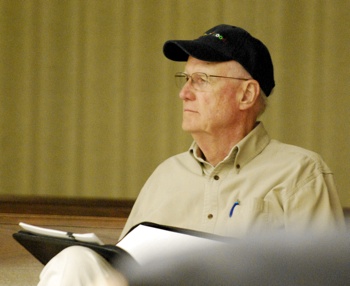
Joe Fitzsimmons, a resident of One North Main, attended the May 20 meeting but did not formally address the planning commission.
Giannola asked why First Martin decided to build an extended-stay hotel, rather than a traditional hotel. Martin said the decision was based on business and market reasons. They did a market study, and one thing missing from this community is hotels with larger rooms and flexibility for longer-term stays. With the university and other organizations in town, an extended-stay hotel seemed to make the most sense. People who have family members in the hospital also need extended-stay facilities, he noted.
Martin explained that each room has a small kitchenette. The hotel won’t provide room service, but breakfast will be provided. If the retail space becomes a restaurant, there might be an opportunity there, he noted.
Clein noted that this project epitomizes the challenges of downtown development. The project is doing some great things, like bringing more activity to an area that needs it, he said. The building is handsome and the preservation of the bus depot facade is good. But there are issues with the neighboring building, so it’s a balancing act, he added. Similar issues will arise as the city gets more downtown development, Clein noted.
Clein said he was empathetic with the neighbors’ concerns, and he hoped First Martin would be proactive in trying to address them. He was supportive of the project, however.
Outcome: Commissioners unanimously recommended approval of the site plan and development agreement, as well as for the plan to install required bicycle parking within the North Ashley and West Huron rights-of-way and the Ann Ashley parking structure.
Downtown Hotel: Public Commentary
During the time for general public commentary at the end of the meeting, around 10:45 p.m., Stephen Ranzini spoke again.
He told commissioners that he’s been a resident at One North Main for 14 years, and has observations about things “that clearly some of you are not aware of.” He thought development agreements were really important, and should be carefully negotiated. The problem in Ann Arbor, he said, is that after a development agreement is reviewed and approved by planning commissioners and the city council, “the city staff has – and often do – change it completely at will.” Projects change radically, he said.
Ranzini said he has suggested to the city attorney, mayor and councilmembers that any material changes to development agreements should require a new approval process. “You’re giving city staff way too much authority to change at-will things,” he said. As an example, he said changes were made for the Ashley Terrace project that related to parking and the number of bedrooms in units. He said the staff will make changes “when the developer cries poverty or economics, which downsize and dumb down the project.” Many projects in the city look awful because of that, he said.
He then brought up issues related to enforcement of existing regulations. He talked about calls he’s made to city police regarding decibel-level violations. Construction repeatedly begins at 5 a.m. when the law requires a 6 a.m. start. He said the police never respond to complaints. Road cleaning occurs at 1 a.m. or 2 a.m., with the noise coming into his windows at more than 120 decibels. “The police response time? Never.” He cited a Huey chopper on Sunday morning – without a permit – generating 200 decibels in his home, as it installed air conditioner units on top of an adjacent building. It was so loud “that my teeth were literally vibrating so much that I was afraid my teeth would come out of my mouth, ok?” Still, the police didn’t respond, he said. Other examples Ranzini cited were bagpipes and city garbage trucks.
Mark Condominiums on Liberty
A site plan for new condominiums at 318 W. Liberty was on the May 20 agenda. Planning staff recommended postponement, however, to allow time for a public water main issue to be addressed.
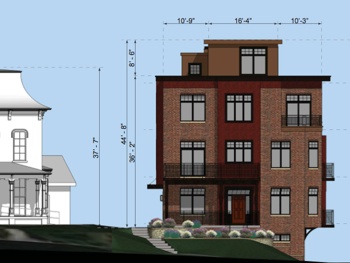
Rendering of Mark Condominium proposal, as viewed from West Liberty next to the former Moveable Feast building.
The proposal from developer Alex de Parry of Ann Arbor Builders Inc. is to demolish an existing car wash and build an 11,910-square-foot structure with seven residential condominiums – five two-bedroom and two three-bedroom units. One unit would face West Liberty, with the others facing east.
Each condo would have its own two-car tandem garage for a total of 14 parking spaces, although no parking is required.
The lot, on the north side of Liberty, is east of the historic Peter Brehme house at 326 W. Liberty and located in the Old West Side historic district. The historic district commission issued a certificate of appropriateness for the project on March 13, 2014. The property is also within the boundaries of the Ann Arbor Downtown Development Authority district. It backs up to the surface parking lot at the city-owned 415 W. Washington.
The property is zoned D2 (downtown interface).
The project would require two footing drain disconnects, according to a staff memo. In addition, the existing six-inch water main in West Liberty Street would need to be upsized to a 12-inch water main. The six-inch main wouldn’t have the capacity to handle the additional development, particularly the building’s fire-suppression system. That was the reason for postponement. [.pdf of staff memo]
The project is expected to cost $2.7 million.
No one spoke during the public hearing for this item.
Mark Condominiums on Liberty: Commission Discussion
Paras Parekh asked staff to elaborate on the water capacity issue. Planning manager Wendy Rampson explained that for every proposed project, the city’s systems planning unit does modeling of its impact on the city’s infrastructure for sewer and water. Typically, the only problems that are encountered are with sewer capacity. But in this case, because this part of the city had been developed with a more residential character, the water main is currently six inches in diameter.
The developer must provide fire suppression for the new building, which would require upsizing to an eight-inch water main. However, the city doesn’t upsize in two-inch increments, Rampson said. So the city is requiring that the water main be upsized to 12 inches. The developer can take on that cost if they want to move quickly, she added, or they can wait until it’s incorporated into the city’s capital improvements plan (CIP).
The upsizing needs to run from Third Street to First Street. The city’s project management staff has said that the developer’s responsibility would be to pay for the upsizing from Third Street to the front of 318 W. Liberty. This requirement emerged just a few days prior to the planning commission meeting, and the developer is now exploring the cost implications of that effort, Rampson said.
Jeremy Peters asked to hear from a representative of the project. Alex de Parry replied that they’re analyzing how to possibly change some construction methods and exploring other options. “We’ve only known about this for about two days,” he noted.
Steve Rojeck of Perimeter LLC, who is also working on this project, added that they’re also evaluating the cost of the upsizing. It could be a substantial impact on the project’s budget, he said.
Sabra Briere asked if the project will include any streetscape improvements. She noted that the site is located within the DDA district, and that the DDA is working on a streetscape project. De Parry replied that they’d received some feedback from residents who attended the project’s citizens participation meeting about adding trees in front of the property. He said they’re working with the owners of the adjacent property to the west – where Moveable Feast restaurant was formerly located – to make sure the grading of the two properties is smooth in front.
Rampson reported that the DDA has asked the developer to coordinate the construction to minimize impact on the parking patrons at 415 W. Washington. The DDA manages the lot as part of its agreement with the city to oversee the public parking system. Rampson added that as far as she knew, there are no streetscape improvements proposed as part of this project.
Kirk Westphal noted that the proposed condominiums will be about half of the proposed density that would be allowed under D2 zoning on that site. De Parry replied that D2 zoning would technically allow for a project that’s up to 60 feet high, but since the site is also in an historic district, there are limitations on height and setbacks.
Rampson explained that the historic district commission has purview to limit the size of the building. The project went before the HDC two times, she said, and as a result it had been scaled back.
De Parry said it’s not a high-density development, with just seven units. So doing a major water main replacement for that is “problematic,” he told commissioners.
Westphal observed that in some cases, the planning commission moves projects along with the stipulation that certain issues must be addressed before going to the city council for approval. De Parry supported that approach, but Rampson noted that this was a big issue and the kind of thing that the planning commission typically addressed before recommending a project. It would likely change some aspects of the development agreement, she added, including a potential cost-sharing arrangement.
Wendy Woods was in favor of postponing, with the hope that it could be brought back to the commission as soon as possible. She said it seemed like the developer was almost in shock, “and understandably so.” Other commissioners agreed regarding postponement.
Outcome: Commissioners voted unanimously to postpone action on the project.
After the vote, de Parry asked whether it was a two-week postponement. Rampson replied that it will come back to the commission as soon as the issues are worked out. It could be two weeks, but it could be longer. The commission’s next meeting is June 3.
Bank of Ann Arbor Expansion
An expansion of the Bank of Ann Arbor headquarters in downtown Ann Arbor was on the May 20 planning commission agenda.
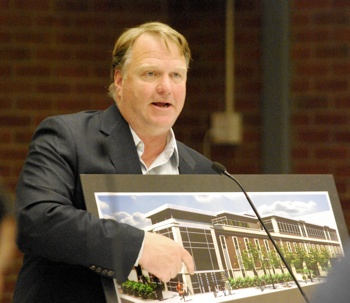
Architect Scott Bowers with a rendering of the expanded downtown Bank of Ann Arbor building and reconfigured entrance, at the northeast corner of Fifth and Washington.
Commissioners were asked to recommend approval of a site plan that involves reorienting the main entrance – moving it from the center of its South Fifth Avenue side to the southeast corner of South Fifth and East Washington. Existing doors will be replaced with windows. A 9,179-square-foot third-floor addition would be constructed over the rear of the building’s east side. In total, the building would be 32,651 square feet after construction. The project is estimated to cost $4.2 million. [.pdf of staff memo]
One outstanding issue relates to a tree that’s needed in one of the landscape islands in the parking lot.
According to the staff memo, the design “seeks to transform the current style from contemporary to traditional by replacing the yellow brick façade with brown and red-colored bricks and limestone-colored stone accents and trim and creating a brick and glass tower at the street corner to create a prominent entry.” The original two-story building was constructed in 1965, which included the drive-thru window. An addition was completed in 1999.
The project was evaluated by the city’s design review board on Jan. 14. The board suggested making the entry structure taller and more closely aligning the bank’s design features with those of the adjacent Ameritech building to the east.
The site is zoned D1, which allows for the highest level of density in the downtown area.
D1 zoning requires a special exception use for drive-thrus, which the planning commission considered on May 20 in a separate vote. Because the project is going through a site plan approval process, the requirement for a special exception use was triggered. Special exception uses do not require additional city council approval. The bank has an existing drive-thru teller window on its north side. No changes are planned to that configuration, however.
In giving the staff report, city planner Alexis DiLeo said if the drive-thru were used more frequently, staff might suggest additional design features, like a more clearly marked crossing or differentiated surface materials. But because there are only 20-25 transactions per day at the drive-thru, and given the “successful history” of the existing drive-thru, staff is comfortable with it remaining as is, DiLeo said.
Modifications to drive-thru regulations are in the works, but not yet enacted. The planning commission approved new drive-thru regulations earlier this year. Amendments to Ann Arbor’s zoning ordinance related to drive-thrus received initial approval at the council’s May 5, 2014 meeting, and will appear on the council’s June 2 agenda for final approval.
Bank of Ann Arbor Expansion: Public Hearing
Scott Bowers, an Ann Arbor architect, introduced his partner, Susan Bowers – both are working on this project. He reviewed details of the project and showed renderings of the proposed building. A tower will be added to the northeast corner entrance, giving it more excitement and movement, he said. The use of glass on the tower will allow pedestrians to see into the lobby. He noted that the issue of the tree in the parking lot landscape island will be addressed.
Bank of Ann Arbor Expansion: Commission Discussion – Site Plan
Sabra Briere noted that there’s a lot of construction underway downtown. Residents have complained, she said, especially about the fact that they can’t walk past projects. She wondered if there was any way for the bank to allow pedestrians to walk on sidewalks while construction takes place.

Bank of Ann Arbor building at the northeast corner of South Fifth and East Washington. The proposed renovations will create a “tower” entrance into the building at this corner.
Scott Bowers said they’d have to see if it could be worked out with the contractor. It probably couldn’t happen during heavy construction periods, he added, but perhaps at other times.
Ken Clein asked whether infiltration would be possible for the stormwater system. Bowers replied that there is infiltration, as part of a water charging system.
Clein clarified that the windows would allow people to see inside the building. He said that’s a benefit, both for the business and for pedestrians. He also confirmed with Bowers that the building’s mechanical systems would be located on top of the new addition. There will be screening around that equipment, Bowers said.
Kirk Westphal asked if the rebricking will look like full-depth brick. Bowers explained that actual brick will be used, after the old yellow brick is stripped off. There will also be stone accents around the windows. Westphal noted that even though it’s not in the planning commission’s purview, it’s nice to see how the architect responded to feedback from the design review board. That information is included in the planning commission’s meeting packet.
Wendy Woods noted that the project is located in the Midtown Character District, and she asked the staff to explain what that means. Alexis DiLeo explained that there are eight character districts. The Midtown Character District is a bit of mishmash now and needs to be more defined, she added. Now, it’s “mostly a government and utility-type feel” with several vacant parcels.
DiLeo also read excerpts from the written staff report:
Midtown Character District – Architectural styles in Midtown include some 19th century wood-framed residential (mostly converted to office use), by stylistically, the district is dominated by an a range of late 20th century mid-rise office and governmental facilities.
The primary north-to-south street in Midtown is Fifth Avenue. It can be considered Ann Arbor’s “civic corridor,” anchored to the south by the Ann Arbor District Library’s Main Branch, the Blake Transit Center and the Federal Building. To the north, directly across E. Huron Street from Midtown, are the Ann Arbor municipal Center and the old and new fire stations and Hands-On Museum.
With the exception of the Library, the buildings in Midtown have limited hours and are used primarily during the business day. Since Midtown is surrounded by character districts with evening-use venues, it often serves as a passage, in particular the west-to-east blocks between Main Street and State Street. Pedestrians seem to be focused on getting from point A to point B and would benefit from more opportunities to linger.
Future development should find opportunities to establish an identity for Midtown, increasing its vitality and expanding its offerings. Primary pedestrian access to buildings along the civic corridor should be from the corridor street.
Jeremy Peters wondered if this expansion would change the hours that the bank would be open. Not at this time, Bowers replied.
Outcome on the site plan resolution: It was approved unanimously. The recommendation will be forwarded to city council for consideration.
Bank of Ann Arbor Expansion: Commission Discussion – Special Exception Use
Diane Giannola confirmed with planning staff that the drive-thru isn’t new, and that the only reason a special exception use is now required is that it’s not automatically grandfathered in, and the need for approval is triggered by the site plan process. Alexis DiLeo explained that the city began requiring special exception uses for drive-thrus in 2009, as part of a broader zoning overhaul known as A2D2 (Ann Arbor Discovering Downtown).
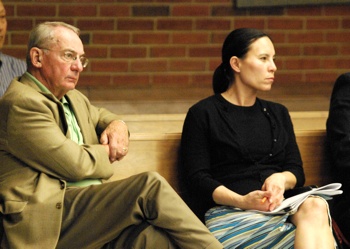
Hans Maier, Bank of Ann Arbor’s senior vice president of specialty banking, and architect Susan Bowers.
The drive-thru now is considered a “legal non-conforming use.” It had been legally established initially, but the zoning code changed, she said. If the bank wasn’t seeking site plan approval, there would be no need for a special exception use.
Responding to a query from Wendy Woods, DiLeo said that if the city council approves amendments to Ann Arbor’s zoning ordinance related to drive-thrus – which were recommended by the planning commission – then any new drive-thru could not be located between the building and the street. Because the bank’s drive-thru is located on the side of the building, it would conform with that future code, she said.
Ken Clein was concerned because it’s an area of “reasonably high” foot traffic. He wondered if the drive-thru would be open beyond normal banking hours. Hans Maier, the bank’s senior vice president of specialty banking, replied that it’s open during regular banking hours on weekdays, and from 9 a.m. until noon on Saturdays. Maier joked that the traffic downtown in the evening isn’t coming to do banking.
Kirk Westphal said this isn’t the kind of use that the city wants to encourage downtown, so he shared Clein’s concern. He wondered if there was an intention to expand the drive-thru hours in the future. Maier indicated that he didn’t think so.
Westphal asked if the special exception use can apply to a different tenant at that location. DiLeo said it could be used as a drive-thru for other types of businesses, not just banking, unless a condition is put on the special exception use. Restrictions could include hours of operation and type of business. Westphal wondered if the condition could restrict the number of people who use the drive-thru daily. DiLeo replied that it would be difficult to enforce that kind of restriction.
Westphal said he wouldn’t be comfortable for this drive-thru being used for another purpose, which might mean longer hours or more traffic.
Sabra Briere proposed an amendment to limit the drive-thru to use by a financial institution. She also asked about time restrictions: Would 7 p.m. be a reasonable time to limit drive-thru operations? Maier told commissioners that the banking business changes, and he indicated that it’s difficult to anticipate what might happen in the future. The bank has been at that location for 18 years, he noted, and hasn’t yet used extended hours. Maier added that given the angle of the curbcuts, it’s not possible to move straight forward from the drive-thru window to the street – there’s a slight curve. Briere said she worried about drivers who aren’t paying attention on Fifth Avenue.
Briere proposed limiting the hours from 8 a.m. until 7 p.m., saying it struck her as “perfectly generous.” She expected in the future, there won’t be a “human attendant” at the drive-thru, so the customers could get out of their car and walk over to the building.
Jeremy Peters asked that Briere separate those two issues – use and hours of operation – so that the amendments could be voted on separately. Briere agreed.
Outcome on limiting the use to financial institutions: The amendment passed on a 6-2 vote, over dissent from Wendy Woods and Eleanore Adenekan. Bonnie Bona was absent.
The commission next considered restricting the hours of operation to between 8 a.m. and 7 p.m.
Paras Parekh wondered if the drive-thru hours would be limited even if it was an automated teller. Sabra Briere said her big concern is the exit onto Fifth Avenue at night.
Jeremy Peters was concerned that if the drive-thru becomes an ATM and there are restricted hours, it would force the bank to turn off the ATM. He thought it would also be hard to regulate, and he hesitated to regulate the hours that a business can be open.
Kirk Westphal asked if a walk-up ATM would be accessible. Hans Maier replied that a walk-up ATM already exists on the same side of the building, near the corner. He noted that the bank’s competitors – including the nearby Comerica and KeyBank branches – wouldn’t have these same restrictions.

Looking east across Fifth Avenue at the Bank of Ann Arbor building. Toward the corner is the green awning of the walk-up ATM. Further east is the awning for the drive-thru teller window.
Diane Giannola said to her, limiting hours of operation seemed like overkill. Cars that parked and used the walk-up ATM would also be driving out that same exit, she noted. Eleanore Adenekan agreed, saying there shouldn’t be restrictions on hours.
Westphal replied that he didn’t want it to be perceived that the planning commission was picking on this bank. He said the same concerns would exist for drive-thrus anywhere in town.
Ken Clein said that trying to legislate the hours of operation might have unintended consequences. He’s comfortable with the amended language that restricts the special exception use to financial institutions. With that, the amount of traffic in the evenings would be much less than if it were a fast food restaurant or pharmacy.
Wendy Woods said she’d vote against regulating hours. She voted against the previous amendment because she wouldn’t have a problem with another drive-thru use at that location – like a pharmacy. “Indeed, it might be an attraction for some people,” she said. She was concerned about restricting the use.
At this point, Briere withdrew her motion, saying “I’m disinclined to vote in favor of the motion myself.” She thought it had been worth the discussion.
Outcome on main motion for granting the special exception use, as amended to limit it to financial institutions: The resolution passed unanimously. It does not require additional approval from the city council.
Fireworks
There were two requests for special exception use related to the sale of Class C fireworks. This is a standard request for this time of year, when temporary sales of fireworks take place. The special exception use can be granted by planning commissioners and doesn’t require additional approval from the city council.
According to the U.S. Consumer Product Safety Commission, Class C fireworks include “shells and mortars, multiple tube devices, Roman candles, rockets, sparklers, firecrackers with no more than 50 milligrams of powder, and novelty items such as snakes, airplanes, ground spinners, helicopters, fountains, and party poppers.”
Fireworks: Phantom
Phantom Fireworks was requesting a special exception use to put up a temporary 40×40-foot tent and an 8×40-foot storage container in the parking lot of the Maple Village Shopping Center at 205 N. Maple, across from Veterans Memorial Park. The purpose would be for the temporary outdoor sales of fireworks, for 10 days around the July 4 holiday – from June 26 to July 5.
The shopping center is in Ward 5.
The tent and container would be set back 44 feet from North Maple Road, and traffic to businesses wouldn’t be impacted, according to city planner Alexis DiLeo, who gave the staff report. The location would be open from about 10 a.m. to 10 p.m., with extended hours depending on sales and demand.
The tent would occupy about 21 of the shopping center’s 1,500 parking spaces. Generally, there’s a lot of available parking there, DiLeo said.
A special exception use is required because this vendor isn’t a permanent tenant of the shopping center, and isn’t being sponsored by any of the tenants.
Approval of the special exception use would allow the sale of fireworks and seasonal products at this location annually, as long as the owner obtains a permit and inspection from the city’s fire marshal each time the tent is put up.
No one spoke during the public hearing for this item. DiLeo reported that no concerns about this proposal have been received. [.pdf of staff report]
Fireworks: Phantom – Commission Discussion
Eleanore Adenekan asked if there’d be extra lighting in that area. Alexis DiLeo replied that the tent will rely on parking lot lighting for the site.
Rick Tapper, regional manager for Phantom Fireworks, came to the podium to answer additional questions. He noted that the company has operated in Ann Arbor for the past two years, but previously were located in the parking lot of Colonial Lanes on South Industrial.
There’s a minimum of two employees in the tent at all times, Tapper said, and at night there are a minimum of three employees. There will be lights inside the tent, run by a generator. The products will be stored at night in the storage unit next to the tent, which is fireproof.
Jeremy Peters asked about the duration of sales: Was that Phantom’s choice? Yes, Tapper replied. He noted that 80% of sales take place during the last three days of business.
Wendy Woods asked about the permanent nature of this special exception use. DiLeo clarified that it would also allow for the sale of “seasonal items” at other times of the year, though that hasn’t been proposed by Phantom Fireworks. Other examples might be gear for Red Wings or University of Michigan sold during football and hockey seasons, respectively. She noted that if the operation is discontinued for three years, the special exception use would be voided.
Wendy Rampson, the city’s planning manager, said that if planning commissioners have concerns about the operation, they should state those issues in the conditions of the special exception use.
Tapper stressed that Phantom Fireworks doesn’t intend to operate at any other time than the 10 days indicated around the July 4 holiday. He was open to the commission striking the phrase “seasonal items” from the special exception use.
Woods moved an amendment to strike the phrase “seasonal items.”
Outcome on amendment: It passed unanimously.
Woods then suggested inserting language to refer to sales during specific dates. Tapper asked that the reference to dates be somewhat general, because the timing of the sales depends on when the weekends fall around July 4.
Peters proposed adding “for a period of up to 15 days total in the months of June and July.”
Outcome on amendment: It passed unanimously.
Kirk Westphal said he assumed this special exception use couldn’t be transferred. DiLeo clarified that it actually could be transferred to another Class C fireworks vendor.
Woods noted that a new skatepark is opening across the street from this shopping center, at Veterans Memorial Park. So she thought it was important to have a few extra conditions on the special exception use.
Outcome on granting the special exception use, as amended: It passed unanimously.
Fireworks: Patriot
The second special exception use request came from Patriot Fireworks, to put up an 8×40-foot temporary unit and 20×20-foot tent in the parking lot of the Twin Valley shopping center at 2750 Jackson Ave., west of the I-94 overpass. It would be set back 45 feet from Jackson and use 5 of the 75 parking spaces.
The business would operate from the Memorial Day weekend through the July 4th holiday, from about noon to 7 p.m., with possible extended hours.
Staff received one call from a resident in the Lakewood neighborhood, located southwest of the shopping center. The resident was concerned that children would cross Jackson Avenue at unsafe locations to get to the fireworks.
Alexis DiLeo of the city’s planning staff reported that staff looked at the site with regard to that concern. She noted that state law restricts fireworks sales to anyone under age 18, so unaccompanied minors wouldn’t likely be crossing Jackson Avenue, she said. “It would be a fruitless cause for them.”
The site is located in Ward 5.
Fireworks: Patriot – Public Hearing
Only one person spoke during the public hearing. Robert Horvath told commissioners that Patriot Fireworks was a local business, with a warehouse on Jackson Road in Scio Township. They sell fireworks at about 40 locations. They’ve been selling fireworks for over a quarter-century, he said. Horvath noted that he’s a “fireworks attorney,” and had sat on the committee that developed the state’s fireworks safety act. “So I’m involved both on a business level, but also on a legal level,” he said.
Fireworks: Patriot – Commission Discussion
Ken Clein asked about plans for signs at this location. Alexis DiLeo replied that businesses are allowed two square feet of signage for every foot of frontage. Since the tent is 20 feet, Patriot would be allowed 40 square feet of signs attached to the tent. They would need a separate city permit for the signs.
Eleanore Adenekan asked how many employees would be on site. Robert Horvath said there would be at least one employee. He described it as more of a “modified store” than a tent, with doors, shelving, lighting and a more controlled environment. It’s also a relatively small area, he noted. They carry about 300 different items.
Jeremy Peters clarified with Horvath that only fireworks would be sold. Horvath didn’t object to striking the term “seasonal items” – as commissioners had done with Phantom Fireworks. But Patriot planned to be open for a longer time than Phantom, he noted.
As she had for the previous special exception use request, Woods moved an amendment to strike the phrase “seasonal items.”
Outcome on amendment: It passed unanimously.
Peters moved an amendment regarding the time of operation, to add the phrase “for a period from three days in advance of Memorial Day, to three days after the July 4th holiday.” Sabra Briere proposed changing “three days after the July 4th holiday” to “July 7.”
Further wordsmithing ensued. Diane Giannola proposed “for a period beginning four days before the Memorial Day holiday and ending four days after the Fourth of July holiday.” Kirk Westphal suggested from May 20 to July 10.
Paras Parekh then proposed “the Thursday before Memorial Day to July 7.” Peters accepted Parekh’s amendment as friendly.
Outcome on amendment: It passed unanimously.
Outcome on granting the special exception use, as amended: It passed unanimously.
Present: Eleanore Adenekan, Sabra Briere, Ken Clein, Diane Giannola, Paras Parekh, Jeremy Peters, Kirk Westphal, Wendy Woods. Also: City planning manager Wendy Rampson.
Absent: Bonnie Bona.
Next meeting: Tuesday, June 3, 2014 at 7 p.m. in council chambers at city hall, 301 E. Huron. [Check Chronicle event listings to confirm date]
The Chronicle survives in part through regular voluntary subscriptions to support our coverage of publicly-funded entities like the city’s planning commission. If you’re already supporting The Chronicle, please encourage your friends, neighbors and coworkers to do the same. Click this link for details: Subscribe to The Chronicle.







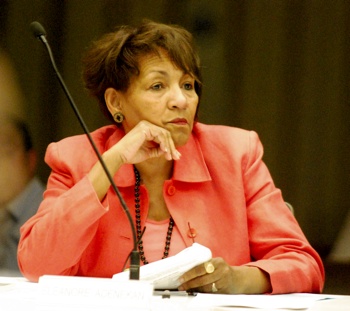
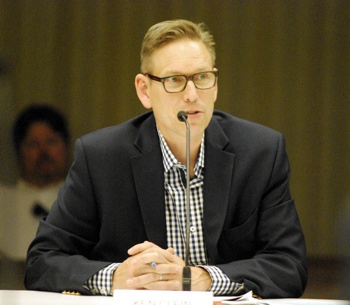


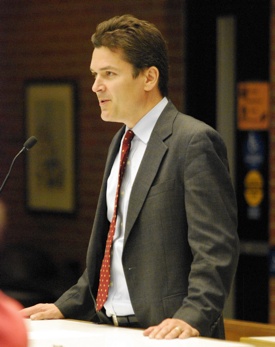
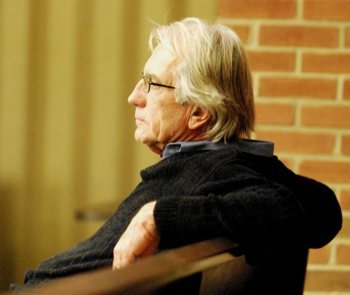
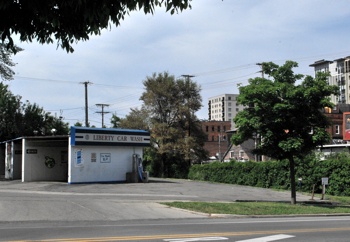
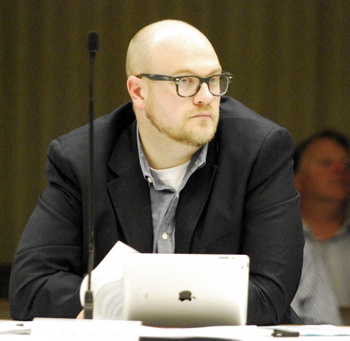

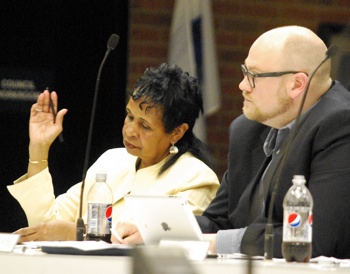
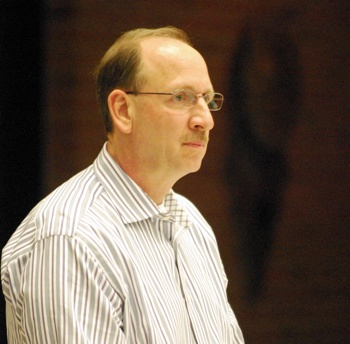
More attempts at micro-management from our un-elected planning commission… limiting hours a drive-thru can be open? Characterizing banks and financial institutions as sub-par businesses because of their presumed inability to “activate the sidewalks”? If I hadn’t seen it with my own eyes I wouldn’t believe it… They let giant apartment towers with no parking be built, sucking up all the public parking, water and sewer resources they wish, but they won’t allow a modest development on Liberty to move forward without costly infrastructure concessions from the developer? Must be quite a power trip to be on that commission – we already know that more than a few commissioners view the voters with great disregard from their public remarks and personal blogs. Now they have the audacity to suggest limits to hours of operation of a thriving local business? Some of these people are pretty out of touch.
(Very) tangentially, let me speak up for restaurateur (no n) as the correct spelling.
@1: Do I detect a little Commission envy? Why aren’t you running for Council this year? I’m sure you could fix all of this audacity and micromanagement once in office. And please be a little more specific re: “we already know that more than a few commissioners view the voters with great disregard from their public remarks and personal blogs”
Who is “we”?
Which Commissioners?
What specific public remarks and personal blogs?